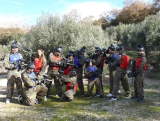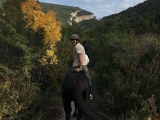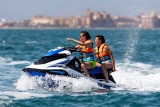Despite this, Menorca contains a fascinating beauty thanks to its near-pristine nature and its charming coves (over a hundred of them) with crystal-clear waters where visibility exceeding 30 metres is not uncommon.
Menorca lies 35 nautical miles from its larger sister island, and its pleasant ambient temperature makes it ideal for visiting during the calm Mediterranean months. You can view all the diving options and prices by clicking here.

If its waters are remarkably clear, its temperature - hovering around 24°C in summer - is equally noteworthy. All these factors make Menorca an excellent destination for water sports, particularly diving.
There are numerous diving spots around the island, from north to south and east to west. Its compact size is an advantage, as when northerly winds prevail, we can head to the southern areas of the island, and vice versa.
In any case, the island's orography, geography or simply the locals' knowledge leads us to iconic diving spots for scuba diving.
We'll distinguish three diving areas in Menorca: one in the north, with tall cliffs and rugged coastline; another in the south with gentler relief and less exposed to the Tramuntana; and a third in the west of the island that leads us to one of the most significant dive sites in the entire Balearics.
Let's begin by naming and briefly describing these diving spots:

- Northern area: This diving zone is actually located on the northeastern side of the island, at Addaia harbour, about 20 km from the capital, Mahon.
Addaia is famous for being one of the safest natural harbours in the island's orography. The historical remains found submerged in its waters confirm this claim. Numerous Roman amphorae and shipwrecks sunk nearby prove that Addaia was a refuge and excellent shelter for ancient navigation.
Cavern diving is one of Menorca's greatest attractions. Countless hollows lead up to air chambers where stalagmites and stalactites form fascinating structures.
Diving in this area is characterised mainly by rugged, irregular walls (formed by constant wave action). Grottoes and underwater caves follow one after another; some with grand air chambers covered in stalagmites and stalactites as silent witnesses to the geological formation that took place thousands of years ago.

Numerous dive sites cluster in this stretch of sea in the island's northeast, where it's common to spot large schools of barracuda prowling the crystal-clear waters in search of small bogue or sardines.
Another species, this time flora, is particularly significant in Addaia - Posidonia oceanica. This seagrass covers vast areas of the seabed and provides shelter for numerous species living among its stems, including pen shells, small crustaceans, seahorses and starfish, serranids and sparids.
- Southern area: Cala Torret is the most recommended destination on this side of the island as, besides having good tourist infrastructure, it's sheltered from the prevailing winds in the Balearics. Protected from the Tramuntana, Gregal and Mistral winds (though not from the Garbí, the southerly wind that can make diving difficult near the cove).
Beyond Cala Torret to the east lies the Isla del Aire, so named for its low height. During easterly storms, the rough waves practically submerge its minimal emerged surface.

You can do numerous dives around the Isla del Aire, just a short boat ride from Cala Torret. Dives in this area are characterised by moderate depths in shallow waters, with most dives ranging between 18 and 25 metres. They're equally notable for extensive Posidonia meadows and, curiously, for hosting many small groupers (locally called Amphós), from juveniles to specimens barely 15cm long.
Cala Torret offers options covering needs from beginners to experts. The former can choose shallow water dives like "Es cagaires", while the latter can opt for cave diving, not forgetting sites like "La barbada de Alcaufar" or the Malakof wreck.
- Eastern area: We'll head to Ciutadella, a charming town with a harbour of unparalleled Mediterranean beauty.
From here, we'll have the chance to dive in the famous "En Pont d'en Gil" cave, with its dozens of metres in length and numerous air chambers (some large enough to walk inside).

Despite initial trepidation about this type of diving, this soon gives way to confidence thanks to the moderate depth and relative ease of breathing without a regulator in the cave's air chambers. The true beauty of these dives lies in observing the fascinating geological formations created by limestone (large submerged and emerged columns, stalagmites and stalactites in colours ranging from white to ochre and dark brown).
- Northeastern area: The Great Cave: This involves a dive in a grotto with moderate difficulty that culminates in a large air chamber.
Just outside the cave it's easy to spot large schools of small fish like bogue or sardines. At about 17 metres depth we enter an immense hollow measuring nearly 32 metres from floor to ceiling and over 6 metres wide. Sunlight penetrates about ten metres inside, but beyond that a dive torch becomes essential to continue exploring the cavity.
The bottom features large rock blocks, likely fallen from the ceiling, sheltering timid crustaceans and the occasional conger eel. About 40 metres in, the depth decreases and an upward slope leads to the huge air chamber, where we can rest awhile and admire the beautiful stalactites and stalagmites.

Clearly, Menorca is a jewel for any diving enthusiast, making it the perfect destination for lovers of this adventure sport.
Ready to discover it?











